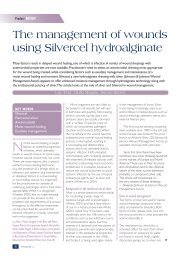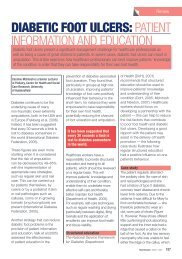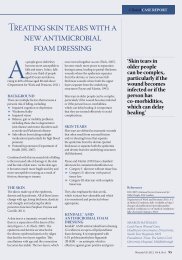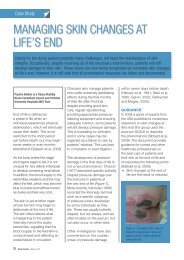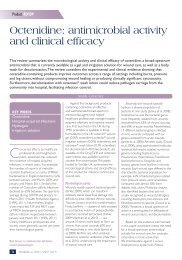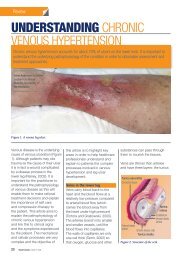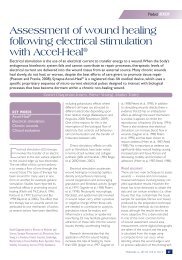What are the quality indicators in wound care? - Wounds UK
What are the quality indicators in wound care? - Wounds UK
What are the quality indicators in wound care? - Wounds UK
You also want an ePaper? Increase the reach of your titles
YUMPU automatically turns print PDFs into web optimized ePapers that Google loves.
Cl<strong>in</strong>ical PRACTICE Cl<strong>in</strong>ical DEVELOPMENT REVIEW<br />
<strong>What</strong> <strong>are</strong> <strong>the</strong> <strong>quality</strong> <strong><strong>in</strong>dicators</strong><br />
<strong>in</strong> <strong>wound</strong> c<strong>are</strong><br />
This paper discusses <strong>quality</strong> <strong><strong>in</strong>dicators</strong> that relate to <strong>wound</strong> c<strong>are</strong>. As cl<strong>in</strong>icians will be assessed aga<strong>in</strong>st<br />
national <strong>quality</strong> <strong><strong>in</strong>dicators</strong> from April 2010, it is important for c<strong>are</strong>rs work<strong>in</strong>g <strong>in</strong> tissue viability to ga<strong>in</strong> an<br />
understand<strong>in</strong>g of what <strong>the</strong>y <strong>are</strong>. The Darzi report (Department of Health, 2008) identified that high <strong>quality</strong><br />
c<strong>are</strong> for patients is an aspiration that is only possible with high <strong>quality</strong> education and tra<strong>in</strong><strong>in</strong>g for all staff<br />
<strong>in</strong>volved <strong>in</strong> NHS services. Cont<strong>in</strong>ued education and promotion of <strong>quality</strong> <strong>in</strong> <strong>the</strong> field of tissue viability will<br />
be more atta<strong>in</strong>able if <strong>the</strong> NHS, higher education <strong>in</strong>stitutions and <strong>in</strong>dustry streng<strong>the</strong>n <strong>the</strong>ir partnerships.<br />
K<strong>are</strong>n Ousey, Richard H Shorney<br />
KEY WORDS<br />
Quality <strong><strong>in</strong>dicators</strong><br />
Pressure ulcers<br />
Lord Darzi<br />
Higher education <strong>in</strong>stitutions<br />
Wound c<strong>are</strong> education<br />
Lord Darzi’s High Quality C<strong>are</strong><br />
for all: NHS Next Stage Review<br />
(Department of Health [DoH],<br />
2008) heralds a new era for <strong>the</strong><br />
NHS where, accord<strong>in</strong>g to <strong>the</strong><br />
National Nurs<strong>in</strong>g Research Unit<br />
(NNRU, 2008), <strong>the</strong> focus on <strong>quality</strong><br />
promises to be relentless. The report<br />
<strong>in</strong>cludes a commitment to hold trusts<br />
accountable for and to reward <strong>quality</strong><br />
of c<strong>are</strong>, and pressure ulcers <strong>are</strong><br />
featured as one of <strong>the</strong> most frequently<br />
cited <strong>quality</strong> <strong><strong>in</strong>dicators</strong>.<br />
While <strong>the</strong> chances of a patient<br />
develop<strong>in</strong>g pressure ulcers may relate<br />
to <strong>the</strong> <strong>quality</strong> of nurs<strong>in</strong>g c<strong>are</strong>, early<br />
detection and proper documentation<br />
K<strong>are</strong>n Ousey is Pr<strong>in</strong>cipal Lecturer, Department of Nurs<strong>in</strong>g<br />
and Health Studies, Centre for Health and Social C<strong>are</strong><br />
Research, University of Huddersfield; Richard H Shorney<br />
is Professional Development Manager, Smith and Nephew<br />
Healthc<strong>are</strong> Ltd<br />
of pressure ulcers is also a marker<br />
of <strong>quality</strong> c<strong>are</strong> which could lead to<br />
higher rates of recorded <strong>in</strong>cidence<br />
<strong>in</strong> good <strong>quality</strong> sett<strong>in</strong>gs than <strong>in</strong> lower<br />
<strong>quality</strong> ones (NNRU, 2008), thus giv<strong>in</strong>g<br />
a skewed <strong>in</strong>dication of a sett<strong>in</strong>g’s<br />
c<strong>are</strong> standards. However, Bennett<br />
et al (2004) warned that while <strong>the</strong><br />
prevalence of pressure ulcers is<br />
established, <strong>the</strong>ir social significance is<br />
harder to quantify and <strong>the</strong> economic<br />
impact can be high.<br />
By select<strong>in</strong>g treatment<br />
that is appropriate to <strong>the</strong><br />
cause and <strong>the</strong> condition<br />
of <strong>the</strong> <strong>wound</strong>, healthc<strong>are</strong><br />
professionals will improve<br />
<strong>the</strong>ir performance <strong>in</strong> l<strong>in</strong>e<br />
with <strong>the</strong> recommendation<br />
to have ‘<strong>quality</strong> at <strong>the</strong> heart<br />
of everyth<strong>in</strong>g we do’ (DoH,<br />
2008)... .<br />
The emphasis on <strong>quality</strong> needs to<br />
be seen <strong>in</strong> <strong>the</strong> context of f<strong>in</strong>ite NHS<br />
resources and <strong>wound</strong> c<strong>are</strong> costs must<br />
also be an ongo<strong>in</strong>g consideration.<br />
The cost of <strong>wound</strong> c<strong>are</strong> to <strong>the</strong> NHS<br />
has been estimated to be £2.3bn and<br />
£3.1bn per year (based on 2005–2006<br />
costs) (Posnett and Franks, 2007). The<br />
DoH (2008) estimated that <strong>the</strong> budget<br />
for <strong>the</strong> NHS <strong>in</strong> England <strong>in</strong> 1996/7 was<br />
£33bn and that <strong>in</strong> <strong>the</strong> year 2008/9 it<br />
would be £96bn. Indeed, White (2008)<br />
stated that <strong>the</strong> trend <strong>in</strong> current NHS<br />
spend<strong>in</strong>g shows that 2008 expenditure<br />
would be about £100bn with <strong>the</strong><br />
best estimates for total costs of tissue<br />
viability be<strong>in</strong>g between £2–3bn (Simon<br />
et al, 2004). White (2008) ma<strong>in</strong>ta<strong>in</strong>ed<br />
that this may be surpris<strong>in</strong>g to some,<br />
but to those <strong>in</strong>volved <strong>in</strong> service<br />
provision it merely re<strong>in</strong>forces <strong>the</strong>ir<br />
conviction that tissue viability is a<br />
substantial burden on NHS funds and<br />
that this will only <strong>in</strong>crease.<br />
The key determ<strong>in</strong>ants of <strong>wound</strong><br />
c<strong>are</strong> costs need to be assessed and<br />
understood by <strong>wound</strong> c<strong>are</strong> specialists.<br />
These variables <strong>in</strong>clude hospitalisation<br />
rates, number of procedures, mean<br />
length of stay, time to heal, frequency<br />
of dress<strong>in</strong>g change, and <strong>the</strong> cost of<br />
all dress<strong>in</strong>g materials per change. It is<br />
<strong>the</strong>refore advisable that trusts employ<br />
<strong>wound</strong> management specialists who<br />
<strong>are</strong> able to collate data aga<strong>in</strong>st <strong>the</strong>se<br />
determ<strong>in</strong>ants when undertak<strong>in</strong>g <strong>the</strong><br />
appropriate management of <strong>wound</strong>s<br />
and <strong>wound</strong> c<strong>are</strong> audits (Hamilton,<br />
2008).<br />
By select<strong>in</strong>g treatment that is<br />
appropriate to <strong>the</strong> cause and <strong>the</strong><br />
condition of <strong>the</strong> <strong>wound</strong>, healthc<strong>are</strong><br />
professionals will improve <strong>the</strong>ir<br />
performance <strong>in</strong> l<strong>in</strong>e with <strong>the</strong><br />
recommendation to have ‘<strong>quality</strong> at<br />
<strong>the</strong> heart of everyth<strong>in</strong>g we do’ (DoH,<br />
2008), and <strong>in</strong> keep<strong>in</strong>g with <strong>the</strong> report’s<br />
<strong>Wounds</strong> <strong>UK</strong>, 2009, Vol 5, No 2<br />
53
Cl<strong>in</strong>ical REVIEW<br />
<strong>are</strong>as of importance:<br />
8 Patient safety<br />
8 Patient experience<br />
8 Effectiveness of c<strong>are</strong>.<br />
Darzi commented that (DoH,<br />
2008): ‘it is imperative that <strong>in</strong> order<br />
to achieve high <strong>quality</strong> c<strong>are</strong> for all<br />
we must build on exist<strong>in</strong>g local<br />
governance’. The report lists <strong>the</strong><br />
follow<strong>in</strong>g seven steps as necessary to<br />
achieve this:<br />
8 Br<strong>in</strong>g clarity to <strong>quality</strong><br />
8 Measure <strong>quality</strong><br />
8 Publish <strong>quality</strong><br />
8 Raise <strong>quality</strong> performance<br />
8 Recognise standards<br />
8 Raise standards<br />
8 Safeguard <strong>quality</strong> and stay ahead.<br />
We <strong>are</strong> about to enter a new<br />
stage of service assessment <strong>in</strong> <strong>the</strong><br />
NHS. For <strong>the</strong> first time <strong>the</strong>re will be<br />
systematic measurement of <strong>quality</strong><br />
and this <strong>in</strong>formation will be published<br />
for all to see. Measures will <strong>in</strong>clude<br />
patients’ views on <strong>the</strong> success of<br />
treatments, <strong>the</strong> <strong>quality</strong> of <strong>the</strong> services<br />
<strong>the</strong>y <strong>are</strong> given and of <strong>the</strong>ir experience<br />
of c<strong>are</strong>. The report promises: ‘<strong>the</strong>re<br />
will be measures of safety and cl<strong>in</strong>ical<br />
outcomes. All registered healthc<strong>are</strong><br />
providers work<strong>in</strong>g for, or on behalf<br />
of, <strong>the</strong> NHS will be required by law<br />
to publish <strong>quality</strong> accounts just as<br />
<strong>the</strong>y publish f<strong>in</strong>ancial accounts’ (DoH,<br />
2008). These <strong>quality</strong> accounts will<br />
need to be published from April<br />
2010 and will centre on <strong>the</strong> <strong>quality</strong><br />
of service provision. The Quality C<strong>are</strong><br />
Commission will provide <strong>in</strong>dependent<br />
validation of performance, us<strong>in</strong>g<br />
<strong><strong>in</strong>dicators</strong> of <strong>quality</strong> set by <strong>the</strong> DoH.<br />
The question <strong>the</strong>n is who is<br />
accountable for <strong>the</strong> <strong>quality</strong> of <strong>the</strong><br />
<strong>wound</strong> c<strong>are</strong> service <strong>in</strong> <strong>the</strong> NHS From<br />
Lord Darzi’s report it is clear to see<br />
that it would be every healthc<strong>are</strong><br />
professional car<strong>in</strong>g for a patient with<br />
a <strong>wound</strong> who would be accountable<br />
for ensur<strong>in</strong>g that all patients <strong>are</strong><br />
offered consistently high <strong>quality</strong> c<strong>are</strong><br />
(DoH, 2008). The report states that:<br />
‘professional regulation has ensured<br />
that practitioners <strong>are</strong> accountable to<br />
<strong>the</strong>ir <strong>in</strong>dividual patients dur<strong>in</strong>g <strong>the</strong>ir<br />
episode of c<strong>are</strong>. By focus<strong>in</strong>g on <strong>the</strong><br />
overall outcome, it means that <strong>the</strong><br />
new accountability is for <strong>the</strong> whole<br />
patient pathway — so cl<strong>in</strong>icians must<br />
be partners as well as practitioners’.<br />
Education and <strong>quality</strong> <strong><strong>in</strong>dicators</strong><br />
Education and promotion of <strong>quality</strong><br />
<strong>in</strong> <strong>the</strong> field of tissue viability is vital<br />
if <strong>wound</strong> c<strong>are</strong>-associated costs <strong>are</strong><br />
to be reduced. Promot<strong>in</strong>g <strong>quality</strong><br />
is by no means new. There have<br />
been several government <strong>in</strong>itiatives<br />
which have attempted to highlight<br />
<strong>the</strong> importance of develop<strong>in</strong>g and<br />
ma<strong>in</strong>ta<strong>in</strong><strong>in</strong>g <strong>quality</strong> over <strong>the</strong> past<br />
few years. Fundamentals of C<strong>are</strong>:<br />
Guidance for Health and Social C<strong>are</strong><br />
Staff (Welsh Assembly Government,<br />
2003) identified <strong>the</strong> importance<br />
of <strong>in</strong>creas<strong>in</strong>g and improv<strong>in</strong>g <strong>the</strong><br />
consistency, <strong>quality</strong> and delivery of<br />
basic c<strong>are</strong>. The National Institute for<br />
Health and Cl<strong>in</strong>ical Excellence (NICE)<br />
guidel<strong>in</strong>e 29 (2005), The Management<br />
of Pressure Ulcers <strong>in</strong> Primary and<br />
Secondary C<strong>are</strong>, highlighted pressure<br />
ulcer risk assessment and prevention,<br />
<strong>in</strong>clud<strong>in</strong>g <strong>the</strong> use of pressure-reliev<strong>in</strong>g<br />
devices for <strong>the</strong> prevention of pressure<br />
ulcers <strong>in</strong> primary and secondary<br />
c<strong>are</strong>. It promotes <strong>the</strong> importance of<br />
education stat<strong>in</strong>g that all healthc<strong>are</strong><br />
professionals should have relevant<br />
tra<strong>in</strong><strong>in</strong>g <strong>in</strong> pressure ulcer prevention<br />
and management.<br />
Now <strong>the</strong> Darzi report has created<br />
its own ambitious visions for <strong>the</strong> NHS<br />
and <strong>the</strong> future of health and health<br />
c<strong>are</strong>. The DoH believes that this<br />
report will enable <strong>the</strong> NHS to achieve<br />
what matters to us, to patients and to<br />
<strong>the</strong> public — improved health and high<br />
<strong>quality</strong> c<strong>are</strong> for all.<br />
In conjunction with <strong>the</strong> Darzi<br />
report, <strong>the</strong> National Nurs<strong>in</strong>g Research<br />
Unit’s State of <strong>the</strong> Art Metrics for<br />
Nurs<strong>in</strong>g: a Rapid Appraisal (2008)<br />
has identified <strong><strong>in</strong>dicators</strong> for <strong>quality</strong>.<br />
The group was asked to identify<br />
mechanisms for giv<strong>in</strong>g nurses tools,<br />
tra<strong>in</strong><strong>in</strong>g and support to improve<br />
<strong>quality</strong> of c<strong>are</strong> across <strong>the</strong> country. This<br />
<strong>in</strong>cludes:<br />
8 Evidence-based metrics to measure<br />
nurse-delivered outcomes and<br />
patient experiences<br />
8 National publication of<br />
performance data to identify<br />
examples of best practice and help<br />
nurses benchmark and improve<br />
<strong>the</strong>ir performance<br />
8 ‘Ward-to-board’ accountability for<br />
<strong>the</strong> <strong>quality</strong> of nurs<strong>in</strong>g c<strong>are</strong>.<br />
This work will support a wider<br />
NHS <strong>in</strong>itiative to establish regional<br />
<strong>quality</strong> observatories and a National<br />
Quality Board that will oversee <strong>the</strong><br />
development of a <strong>quality</strong> measurement<br />
framework for all cl<strong>in</strong>ical services.<br />
Darzi (DoH, 2008) has identified<br />
that high <strong>quality</strong> c<strong>are</strong> for patients is an<br />
aspiration that is only possible with high<br />
<strong>quality</strong> education and tra<strong>in</strong><strong>in</strong>g for all<br />
staff <strong>in</strong>volved <strong>in</strong> NHS services as <strong>the</strong>y<br />
provide c<strong>are</strong> <strong>in</strong> a chang<strong>in</strong>g healthc<strong>are</strong><br />
environment. Gottrup (2003) stated that<br />
all staff work<strong>in</strong>g with problem <strong>wound</strong>s<br />
should have a certa<strong>in</strong> level of education<br />
and tra<strong>in</strong><strong>in</strong>g that allows <strong>the</strong>m to provide<br />
and improve <strong>wound</strong> c<strong>are</strong>. Indeed,<br />
Gerrish et al (2007) ma<strong>in</strong>ta<strong>in</strong> that <strong>in</strong><br />
order for nurses to make a difference<br />
with<strong>in</strong> <strong>the</strong>ir chosen specialty, <strong>the</strong>y must<br />
embrace evidence-based practice as<br />
<strong>the</strong> key driver of government health<br />
policies: a goal frequently cited by <strong>the</strong><br />
nurs<strong>in</strong>g profession. However, much of<br />
<strong>the</strong> responsibility for evidence-based<br />
practice has been placed on <strong>in</strong>dividual<br />
practis<strong>in</strong>g nurses. This responsibility<br />
needs to be sh<strong>are</strong>d across all parties<br />
<strong>in</strong>volved <strong>in</strong> <strong>wound</strong> c<strong>are</strong>, <strong>in</strong>clud<strong>in</strong>g<br />
healthc<strong>are</strong> providers, education and<br />
<strong>in</strong>dustry.<br />
Promot<strong>in</strong>g <strong>quality</strong> through<br />
effective partnerships<br />
Sixty percent of staff who will deliver<br />
NHS services <strong>in</strong> 10 years time <strong>are</strong><br />
already work<strong>in</strong>g <strong>in</strong> health c<strong>are</strong> and<br />
<strong>the</strong>y must be able to keep <strong>the</strong>ir<br />
skills and knowledge up to date<br />
(DoH, 2008). An understand<strong>in</strong>g of<br />
<strong>the</strong> required skill set <strong>in</strong> <strong>wound</strong> c<strong>are</strong><br />
is essential to provide adequate<br />
education. Cl<strong>in</strong>ical and non-cl<strong>in</strong>ical<br />
skills <strong>are</strong> both needed for a <strong>quality</strong><br />
service <strong>in</strong> health c<strong>are</strong>. The health<br />
service, and <strong>wound</strong> c<strong>are</strong> as a<br />
specialty, <strong>are</strong> becom<strong>in</strong>g more bus<strong>in</strong>ess<br />
orientated (Castled<strong>in</strong>e, 2006).<br />
Understand<strong>in</strong>g and application of non-<br />
54<br />
<strong>Wounds</strong> <strong>UK</strong>, 2009, Vol 5, No 2
Cl<strong>in</strong>ical REVIEW<br />
cl<strong>in</strong>ical skills, <strong>in</strong>clud<strong>in</strong>g bus<strong>in</strong>ess acumen,<br />
<strong>are</strong> essential to support a service that<br />
is both good <strong>quality</strong> and cost-effective.<br />
In cl<strong>in</strong>ical practice and more<br />
specifically <strong>in</strong> <strong>wound</strong> c<strong>are</strong>, <strong>the</strong>re<br />
<strong>are</strong> tremendous variations <strong>in</strong> <strong>the</strong><br />
knowledge and skills of <strong>in</strong>dividual<br />
healthc<strong>are</strong> professionals <strong>in</strong>volved.<br />
Despite an acknowledged <strong>the</strong>orypractice<br />
gap, education is often viewed<br />
as an effective method of facilitat<strong>in</strong>g<br />
change <strong>in</strong> cl<strong>in</strong>ical practice (Gibson and<br />
McAloon, 2006). Improv<strong>in</strong>g knowledge<br />
base <strong>in</strong> <strong>the</strong> <strong>wound</strong> c<strong>are</strong> sett<strong>in</strong>g is<br />
essential to stay abreast of current<br />
trends and advanc<strong>in</strong>g technologies.<br />
Moreover, how this knowledge is<br />
applied to everyday practice is of<br />
utmost importance (Hard<strong>in</strong>g, 2000).<br />
The Darzi report (2008) states<br />
that by creat<strong>in</strong>g new partnerships<br />
between <strong>the</strong> NHS, universities and<br />
<strong>in</strong>dustry, <strong>the</strong>se ‘clusters’ will enable<br />
pioneer<strong>in</strong>g new treatments and<br />
models of c<strong>are</strong> to be developed and<br />
<strong>the</strong>n delivered directly to patients. By<br />
streng<strong>the</strong>n<strong>in</strong>g <strong>the</strong>se connections staff<br />
will have consistent and equitable<br />
opportunities to update and develop<br />
<strong>the</strong>ir skills. Watret (2005) suggested<br />
that by <strong>in</strong>volv<strong>in</strong>g higher education, <strong>the</strong><br />
partnership between <strong>in</strong>dustry, higher<br />
education <strong>in</strong>stitutions and health<br />
c<strong>are</strong> can ensure <strong>quality</strong> assurance<br />
<strong>in</strong> educational provision, whereby<br />
everyone concerned can place a<br />
value and relevance on <strong>the</strong> education<br />
accessed. The content of educational<br />
resources must be practice-driven and<br />
consistently relevant to professional<br />
practice. Additionally, <strong>the</strong> effective<br />
and equitable use of resources and<br />
a multiprofessional approach to<br />
deliver<strong>in</strong>g c<strong>are</strong> will allow <strong>the</strong> challenges<br />
set by Lord Darzi to be achieved.<br />
Conclusion<br />
For <strong>wound</strong> c<strong>are</strong> to be fully recognised<br />
as a speciality it will need to align to<br />
its specific <strong><strong>in</strong>dicators</strong>. Healthc<strong>are</strong> and<br />
<strong>in</strong>dustry will need to fully understand<br />
<strong>the</strong> <strong><strong>in</strong>dicators</strong> and engage with <strong>the</strong><br />
requirements. Only <strong>the</strong>n will <strong>wound</strong><br />
c<strong>are</strong> be moved up <strong>the</strong> political agenda<br />
and ga<strong>in</strong> <strong>the</strong> focus and attention it<br />
deserves. As <strong>the</strong> skill set required to<br />
offer a <strong>quality</strong> assured <strong>wound</strong> c<strong>are</strong><br />
service is evolv<strong>in</strong>g, so too does <strong>the</strong><br />
education provided to support <strong>the</strong><br />
healthc<strong>are</strong> professionals work<strong>in</strong>g <strong>in</strong><br />
this healthc<strong>are</strong> <strong>are</strong>na. To enable <strong>wound</strong><br />
c<strong>are</strong> to embrace <strong>the</strong> challenges set<br />
by <strong>the</strong> Darzi report (DoH, 2008), a<br />
stronger work<strong>in</strong>g relationship will need<br />
to be made between <strong>the</strong> NHS, higher<br />
education <strong>in</strong>stitutions and <strong>in</strong>dustry.<br />
References<br />
Bennett G, Dealey C, Posnett J (2004)<br />
The cost of pressure ulcers <strong>in</strong> <strong>the</strong> <strong>UK</strong>. Age<br />
Age<strong>in</strong>g 33(3): 230–5<br />
Castled<strong>in</strong>e G (2006) Accelerat<strong>in</strong>g<br />
workforce redesign: threat or stimulus. Br J<br />
Nurs<strong>in</strong>g 15(18): 208<br />
Department of Health (2008) High Quality<br />
C<strong>are</strong> For All NHS. Next Stage Review F<strong>in</strong>al<br />
Report CM78432. DoH, London<br />
Gerrish K, Ashworth P, Lacey A, et<br />
al (2007) Factors <strong>in</strong>fluenc<strong>in</strong>g <strong>the</strong><br />
development of evidence-based practice: a<br />
research tool. J Adv Nurs<strong>in</strong>g 57(3): 328–38<br />
Gibson L, McAloon M (2006) How do<br />
nurses perceive <strong>the</strong> role of <strong>the</strong> TVNS<br />
<strong>Wounds</strong> <strong>UK</strong> 2(4): 36–50<br />
Gottrup F (2003) Optimiz<strong>in</strong>g <strong>wound</strong><br />
treatment through health c<strong>are</strong> structur<strong>in</strong>g<br />
and professional education. Wound Rep<br />
Regen 12(2): 129–33<br />
Hamilton C (2008) Speculat<strong>in</strong>g to<br />
accumulate: reduc<strong>in</strong>g <strong>the</strong> cost of <strong>wound</strong><br />
c<strong>are</strong> by appropriate dress<strong>in</strong>g selection. J<br />
Wound C<strong>are</strong> 17(8): 359–63<br />
W<strong>UK</strong><br />
Hard<strong>in</strong>g K (2000) Evidence and <strong>wound</strong><br />
c<strong>are</strong>: what is it J Wound C<strong>are</strong> 9(4): 188–90<br />
National Institute for Health and Cl<strong>in</strong>ical<br />
Excellence (2005) The Management of<br />
Pressure Ulcers <strong>in</strong> Primary and Secondary<br />
C<strong>are</strong>: A Cl<strong>in</strong>ical Practice Guidel<strong>in</strong>e.<br />
[CG29]. NICE, London. Available onl<strong>in</strong>e<br />
at: www.nice.org.uk/nicemedia/pdf/<br />
CG029fullguidel<strong>in</strong>e.pdf (Last accessed 31<br />
October, 2007)<br />
National Nurs<strong>in</strong>g Research Unit (2008)<br />
State of <strong>the</strong> art metrics for nurs<strong>in</strong>g: a rapid<br />
appraisal. K<strong>in</strong>gs College, London. Available<br />
onl<strong>in</strong>e at: www.kcl.ac.uk/content/1/<br />
c6/04/32/19/Metricsf<strong>in</strong>alreport.pdf (last<br />
accessed 14 March, 2009)<br />
Posnett J, Franks PJ (2007) The costs of<br />
sk<strong>in</strong> breakdown and ulceration <strong>in</strong> <strong>the</strong> <strong>UK</strong>.<br />
The silent epidemic. The Smith & Nephew<br />
Foundation, Hull<br />
Simon DA, Dix FP, McCollum CN (2004)<br />
Management of venous leg ulcers. Br Med J<br />
328: 1358–62<br />
Watret L (2005) Teach<strong>in</strong>g <strong>wound</strong><br />
management: a collaborative model<br />
for future education. Available onl<strong>in</strong>e<br />
at: www.worldwide<strong>wound</strong>s.com/2005/<br />
november/Watret/Teach<strong>in</strong>g-Wound-Mgt-<br />
Collaborative-Model.html#ref14 (last<br />
accessed 14 March, 2009)<br />
Welsh Assembly Government (2003)<br />
Fundamentals of C<strong>are</strong>: Guidance for Health<br />
and Social C<strong>are</strong> Staff. Welsh Assembly<br />
Government, Cardiff. Available onl<strong>in</strong>e at:<br />
http://new.wales.gov.uk/docrepos/40382/<br />
dhss/510356/booklete (last accessed 14<br />
March, 2009<br />
White R (2008) Tissue viability <strong>in</strong><br />
tomorrow’s NHS. J Wound C<strong>are</strong> 17(3):<br />
97–99<br />
Key po<strong>in</strong>ts<br />
8 Every healthc<strong>are</strong> professional<br />
car<strong>in</strong>g for a patient with a<br />
<strong>wound</strong> will be accountable<br />
for ensur<strong>in</strong>g that all patients<br />
<strong>are</strong> offered consistently high<br />
<strong>quality</strong> c<strong>are</strong>.<br />
8 Trusts will soon be required<br />
to measure <strong>the</strong> <strong>quality</strong> of<br />
<strong>the</strong> c<strong>are</strong> <strong>the</strong>y give <strong>in</strong> relation<br />
to certa<strong>in</strong> <strong>quality</strong> <strong><strong>in</strong>dicators</strong>.<br />
This <strong>in</strong>formation will be<br />
published for all to see.<br />
8 Key determ<strong>in</strong>ants of <strong>wound</strong><br />
c<strong>are</strong> costs need to be<br />
assessed and understood by<br />
<strong>wound</strong> c<strong>are</strong> specialists.<br />
8 By select<strong>in</strong>g treatment<br />
that is appropriate to <strong>the</strong><br />
cause and <strong>the</strong> condition<br />
of <strong>the</strong> <strong>wound</strong>, healthc<strong>are</strong><br />
professionals will improve<br />
<strong>the</strong>ir performance aga<strong>in</strong>st<br />
‘<strong>quality</strong> at <strong>the</strong> heart of<br />
everyth<strong>in</strong>g we do’.<br />
8 To enable <strong>wound</strong> c<strong>are</strong> to<br />
embrace <strong>the</strong> challenges set<br />
by <strong>the</strong> High Quality C<strong>are</strong> for<br />
All report (DoH, 2008), a<br />
strong work<strong>in</strong>g relationship<br />
will need to be met<br />
between <strong>the</strong> NHS, HEIs<br />
and <strong>in</strong>dustry.<br />
<strong>Wounds</strong> <strong>UK</strong>, 2009, Vol 5, No 2<br />
55



